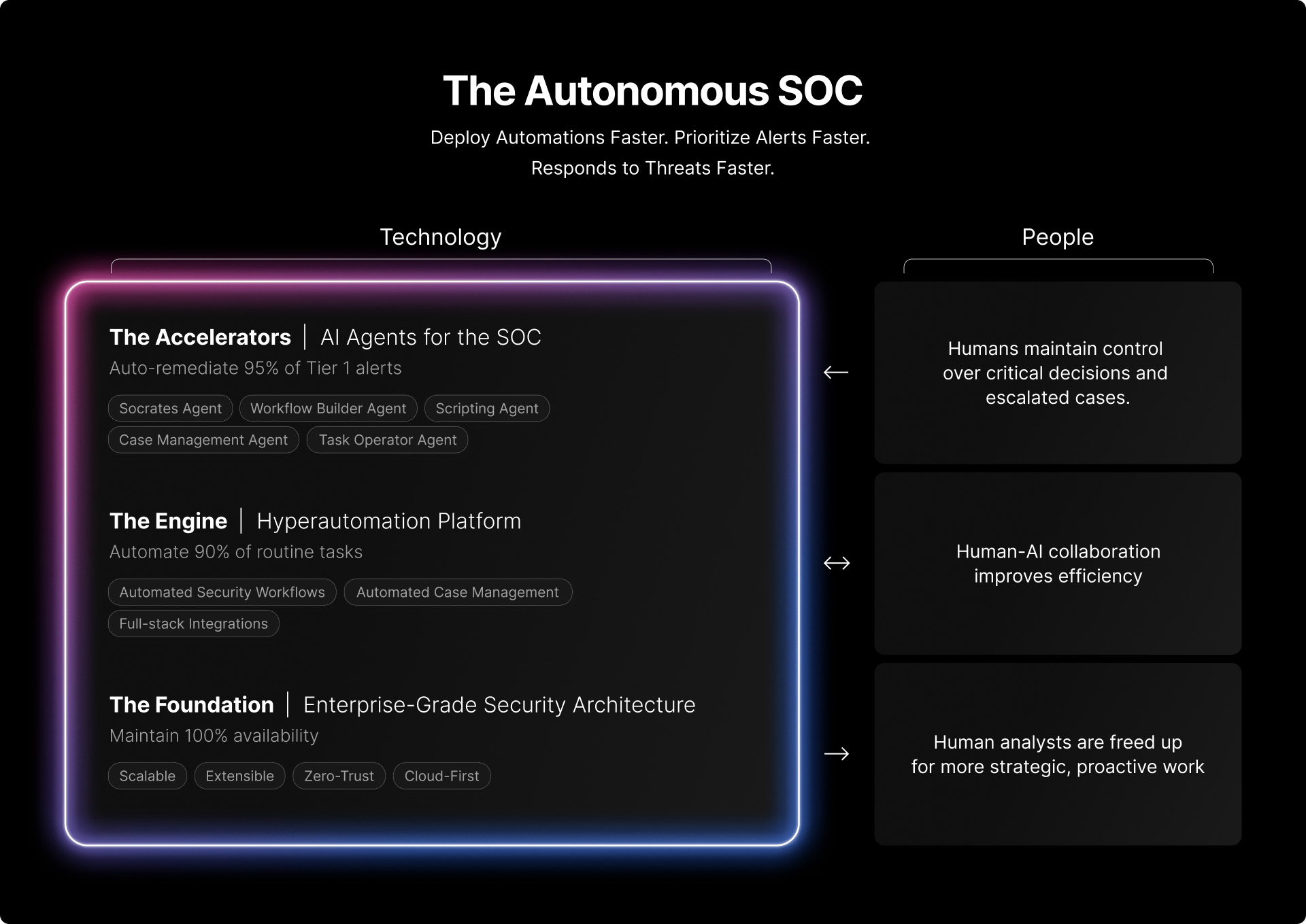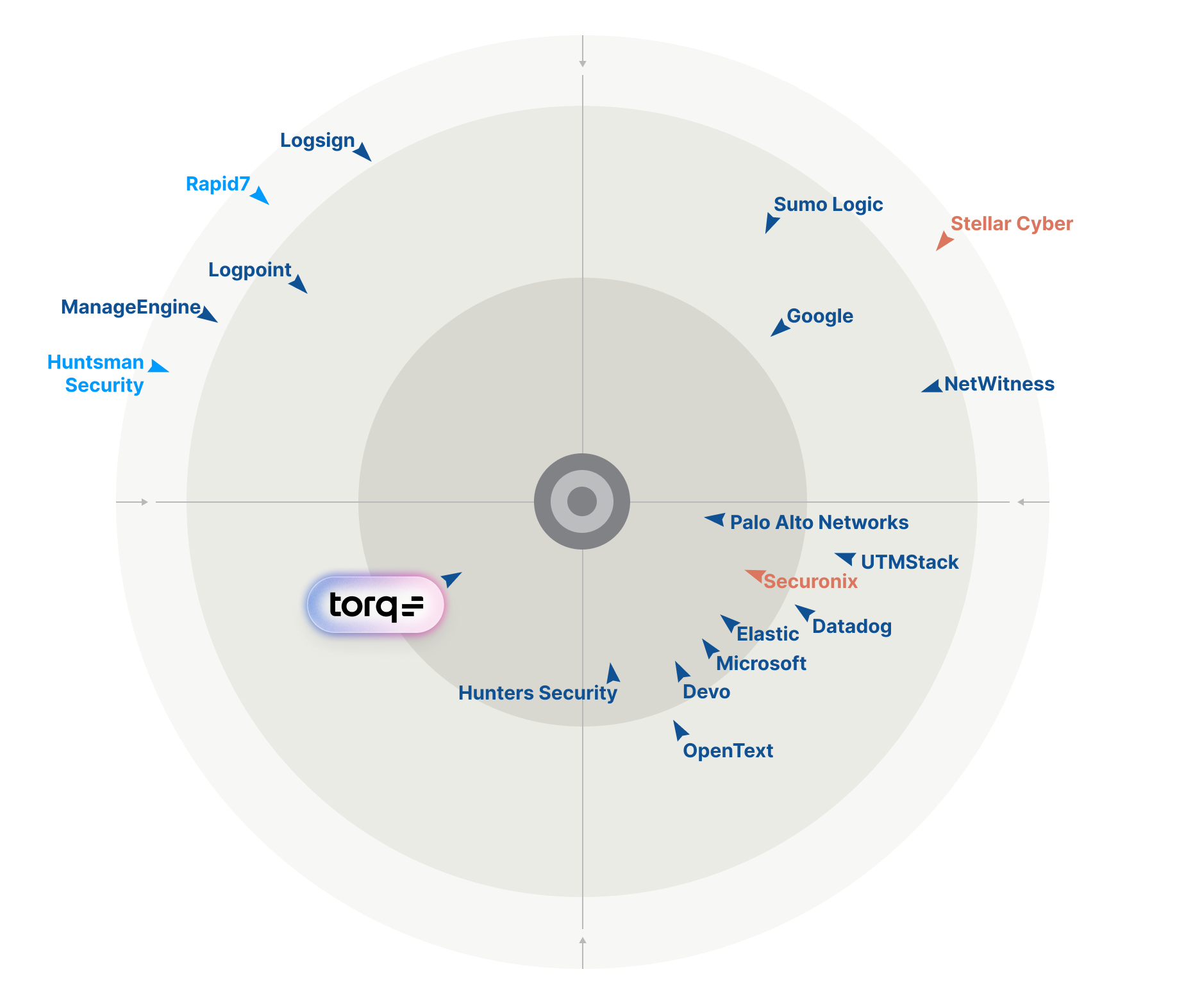What is an
Autonomous SOC?
The concept of an “autonomous SOC” is popping up everywhere lately as a promising solution to streamline security operations processes, reduce analyst alert fatigue, and improve overall security posture, as seen in GigaOm’s newest Radar Report on Autonomous SOC solutions. But how does the dream of an autonomous SOC play out in the real world of security operations?
Below, we break down the components of and practical considerations for achieving an autonomous SOC.
Definition of an Autonomous SOC
An autonomous SOC is a security operations center that leverages automation and artificial intelligence (AI) to streamline security operations, improve efficiency, and accelerate incident response. By tirelessly automating routine tasks, intelligently prioritizing, investigating, and remediating alerts around-the-clock, and enriching case data with contextual information and threat intelligence, autonomous SOCs help accelerate response times and free up human analysts to focus on more rewarding, strategic activities, addressing the combined challenge of staying ahead of evolving, AI-driven threats at scale amidst a cybersecurity talent shortage.
The Right Balance of Autonomy in the SOC
The end goal of deploying AI and automation in the SOC isn’t to replace humans, but to enhance them. With a looming cybersecurity staffing shortage, many SOCs can’t simply add headcount to address the growing volume of threats. By autonomously processing alerts and automating day-to-day grunt work, an autonomous SOC allows the limited resource of human expertise to be prioritized for high-priority cases and strategic projects.
However, while human-in-the-loop control is important in AI systems, efficiency gains are lost if human analysts have to babysit every AI decision. There must be some level of trust in the AI to execute remediation actions within its purview. That’s why it’s crucial that AI in the SOC is deployed with structured guardrails and transparency into the AI’s logic for how it reached its conclusions alongside citations to original, forensic evidence.
![]()
“Autonomous security operations center (SOC) solutions shift security analysts’ focus from repetitive tasks to investigating only the most important incidents.
The SOC will not — and should not — be fully autonomous. Instead, it should be given the autonomy only to deal with the biggest hindrance for analysts: volume of responses.
…High-volume, low-complexity attack responses can often be fully automated, enabling businesses to dedicate analysts to truly important attacks, such as unknown or zero-day attacks.”
Components of an Autonomous SOC
An autonomous SOC requires three key components: Hyperautomation, SOC-specific AI agents, and enterprise-grade security architecture.

1. Hyperautomation:
The Engine
An autonomous SOC simply isn’t possible without automation. When legacy SOAR platforms couldn’t deliver on their promise of security automation due to rigid architecture and limited scalability, Security Hyperautomation emerged (and just like that, SOAR was obsolete).
Unlike SOAR, Hyperautomation offers unlimited integrations, cloud-native scalability, automated case management, and the ability to create impactful workflow automations in minutes — all of which combines to hyperautomate 90% of Tier 1 SOC operations.
2. AI Agents for the SOC:
The Accelerators
SOC teams are overloaded with false positives and information from the threat alerts coming in from ever-growing security stacks. Agentic AI for security operations can handle the majority of every day alerts autonomously, helping cut through the noise and absorbing the heavy lifting of alert triage to reduce analyst burnout while dramatically accelerating response times.
Large Language Models (LLMs) excel at intaking huge volumes of data and rapidly distilling them down to find patterns and summarize information. AI agents for the SOC that leverage LLMs can tirelessly analyze massive volumes of security incidents, assess what other agents are required to mitigate threats, and then coordinate or assign tasks to the necessary specialized agents — automating the investigation process from start to resolution.
These processes mirror human team collaboration, where AI agents will even learn from each other so every autonomously resolved incident helps further educate each individual agent to become a stronger expert in its specific task.
AI-driven autonomous incident response can enable SOCs to clear out 95% of Tier 1 and Tier 2 tickets, freeing human analysts to zero in on critical, high-impact threats. Additionally, for those cases that require human-in-the-loop intervention, AI can help analysts make better, faster decisions by connecting the dots between multiple different tools and signals and applying third party threat intelligence info to contextually enrich cases and provide deeper insights.
3. Enterprise-Grade Architecture: The Foundation
To succeed in today’s data-rich, cloud-native world, an autonomous SOC must be underpinned by an extensible security architecture that can integrate seamlessly with the full security stack and ingest, consolidate, and transform data in any format.
A data pipeline of this magnitude has the potential to produce tens of thousands — even millions — of alerts, events, and requests, which requires an architecture supported by elastic scalability that can automatically adjust its resources to handle increasing data loads. This allows for concurrent processing of different data types with customized processing speeds based on priority, ensuring that high-priority data is always processed as quickly as possible, even during peak loads.
Is an autonomous SOC the same as an AI-powered SOC?
While an autonomous SOC and an AI-powered SOC are closely related, they’re not exactly the same — and an autonomous SOC is much, much more than simply having an AI SOC agent for your analysts to chat with.
An AI-powered SOC encompasses any SOC that deploys AI technologies such as Large Language Models (LLMs) and Generative AI to enhance its operations. This can include automating workflows, improving threat detection, and accelerating incident response.
An Autonomous SOC refers to a SOC that strategically leverages automation and AI to independently perform many security operations tasks, including autonomously analyzing, triaging, investigating, and even remediating low-level alerts. It aims to reduce human workloads for the most time-consuming, labor-intensive tasks, but humans still play a crucial role in oversight and decision-making.
How Automation and AI Help SOCs Win
Security teams are in an AI arms race. As adversaries increasingly leverage AI to search for vulnerabilities 24/7 and launch attacks at scale with nearly limitless variation, most organizations are recognizing that it’s nearly impossible for humans alone to keep pace with today’s quantity and complexity of threats — especially in the midst of a cybersecurity talent shortage that has teams strained to their limits.
An autonomous SOC supplements security teams by providing tireless, around-the-clock alert triage, investigation, and response, leading to:
Enhanced security posture
- Improved threat detection and response by leveraging AI analysis to connect the dots between multiple tools and apply third-party threat intelligence for deeper insights.
- Reduced alert fatigue by clearing out the noise through automated alert triage that reduces false positives and intelligently escalates critical alerts.
- More proactive and resilient security posture by using AI to identify and respond to emerging threats while freeing up human analysts for threat hunting.
More efficient operations
- Freeing human security analysts to focus on higher-value activities by automating repetitive, time-consuming security operations processes and using AI to generate documentation, transform data, and quickly build workflows.
- Faster incident resolution thanks to intelligent prioritization, AI-accelerated investigation and response, and contextual case enrichment.
- Skills upleveling for junior analysts who can operate at higher levels without needing to be an expert in every tool or spend a lot of time coding, thanks to AI’s ability to translate natural language commands into technical actions.
Increased productivity
- Reduced analyst burnout by automating tasks to focus on more rewarding work.
- Optimized resource allocation by intelligently assigning case workloads.
- Cost savings through increased efficiency, reduced operational overhead, and minimized security breaches.
Extend Your Security Investments with HyperSOC™
It’s difficult to maximize the value of an autonomous SOC without an automation engine to extend AI efficiencies into every corner of your SOC. Hyperautomation’s ability to seamlessly connect with any security solution — and effortlessly ingest and process massive amounts of data without failure — makes it the perfect foundation to act as a delivery system for deeply embedding AI across the entire security operations lifecycle.
Torq HyperSOC™ combines the power of Hyperautomation and agentic AI to revolutionize security operations. HyperSOC automates, manages, and monitors critical SOC responses at machine speed and leverages natural language processing (NLP) for contextual case insights, empowering security teams to respond faster, streamline case management, and be more efficient.
Accelerate incident response
Socrates, Torq’s AI SOC Analyst in HyperSOC, can autonomously investigate and resolve 95% of Tier-1 incidents through predefined runbooks. For complex cases, human-in-the-loop investigations are facilitated by human-AI collaboration through natural language text queries. By leveraging AI-native insights and automation, human analysts can quickly understand the nature of high-priority threats and take decisive, informed action.
Enhance case management
Torq HyperSOC streamlines case management by intelligently prioritizing alerts based on severity and impact. Quickly grasp the full scope of security incidents in seconds, with an easily digestible AI-generated summary and receive contextual next steps and recommended actions to accelerate decision-making speed.
Optimize SOC efficiency
With Torq HyperSOC, you can automate any security process in seconds using AI to leverage 300+ pre-built integrations and thousands of out-of-the-box actions to connect your security stack. Rapidly build and deploy workflows and transform data using natural language text prompts, while retaining full control.
By supercharging the connections, data transfer, analysis, and automation across your existing security solutions, HyperSOC helps maximize the value of your entire security stack.
“Torq helps customers get the biggest bang for their security buck, maximizing the value of their existing security investments.”
Micah Donald, Sr. Director, Solutions Engineering at Deepwatch
Torq HyperSOC™: GigaOm Autonomous SOC Leader

In the new Autonomous SOC Radar Report, GigaOm recognized Torq as the only Hyperautomation vendor capable of delivering true autonomy to the SOC.
Torq scored 5 stars for LLM integrations due to mature, fully operationalized AI capabilities that embed naturally into daily SOC operations.
For an independent evaluation of Torq HyperSOC’s unique advantages compared to legacy platform players in achieving an autonomous SOC, read the full report.




